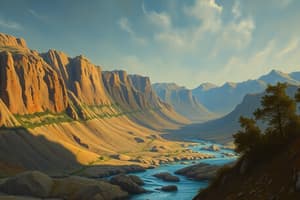Podcast
Questions and Answers
What characterizes clastic sediments?
What characterizes clastic sediments?
- They consist of fragmented rock and mineral particles. (correct)
- They are created by mineral precipitation from solutions.
- They are formed through biological processes.
- They are only found in marine environments.
Which sediment transport mechanism is primarily responsible for the formation of dunes?
Which sediment transport mechanism is primarily responsible for the formation of dunes?
- Hydraulic transport
- Sedimentary transport
- Glacial transport
- Aeolian transport (correct)
What is the primary difference between well-sorted and poorly sorted sediments?
What is the primary difference between well-sorted and poorly sorted sediments?
- Well-sorted sediments are transported by ice.
- Well-sorted has a wider range of particle sizes.
- Poorly sorted contains similar sized particles.
- Poorly sorted sediments have a variance in particle sizes. (correct)
In which type of environment would one likely find biogenic sediments?
In which type of environment would one likely find biogenic sediments?
Which of the following processes is considered diagenesis?
Which of the following processes is considered diagenesis?
What do graded beds in sedimentary structures indicate?
What do graded beds in sedimentary structures indicate?
Which of the following is NOT a type of sediment?
Which of the following is NOT a type of sediment?
How does sedimentology contribute to understanding natural hazards?
How does sedimentology contribute to understanding natural hazards?
Flashcards are hidden until you start studying
Study Notes
Overview of Sedimentology
- Sedimentology is the study of sediment, its formation, transportation, and deposition.
- It is a sub-discipline of geology and plays a critical role in understanding sedimentary rocks.
Types of Sediments
-
Clastic Sediments
- Composed of fragmented rock and mineral particles.
- Examples include sand, silt, and clay.
-
Chemical Sediments
- Formed through the precipitation of minerals from solution.
- Common examples include limestone and evaporites (e.g., halite).
-
Biogenic Sediments
- Formed from the accumulation of biological materials.
- Examples include coal and chalk.
Sediment Transport Mechanisms
- Water (Hydraulic Transport)
- Sediments carried by rivers, streams, and ocean currents.
- Wind (Aeolian Transport)
- Sediments moved by wind action, often forming dunes.
- Ice (Glacial Transport)
- Sediments transported by glaciers, resulting in unique landforms.
Sedimentary Environments
- Marine Environments
- Includes continental shelves, deep-sea, and coral reefs.
- Terrestrial Environments
- Includes rivers, lakes, and deserts.
- Transition Zones
- Areas where marine and terrestrial systems interact, such as deltas and estuaries.
Sediment Grading
- Sorting
- The distribution of particle sizes; well-sorted (similar sizes) vs. poorly sorted (varied sizes).
- Graded Beds
- Layers that show a vertical change in particle size, typically from coarse at the bottom to fine at the top.
Diagenesis
- The process of chemical, physical, and biological changes occurring in sediments after deposition.
- Includes compaction, cementation, and the formation of sedimentary rocks.
Importance of Sedimentology
- Provides insights into Earth's history and past environments.
- Essential for resource exploration (e.g., hydrocarbons, groundwater).
- Aids in understanding sediment-related hazards (e.g., landslides, flooding).
Overview of Sedimentology
- Study of sediment encompasses its formation, transportation, and deposition.
- A vital sub-discipline within geology, crucial for understanding sedimentary rocks.
Types of Sediments
- Clastic Sediments
- Formed from fragmented rock and mineral particles.
- Common examples include sand, silt, and clay.
- Chemical Sediments
- Created by the precipitation of minerals from solutions.
- Includes limestone and evaporites like halite.
- Biogenic Sediments
- Result from the accumulation of biological materials.
- Notable examples are coal and chalk.
Sediment Transport Mechanisms
- Water (Hydraulic Transport)
- Sediments are carried by rivers, streams, and ocean currents.
- Wind (Aeolian Transport)
- Wind action moves sediments, leading to the formation of dunes.
- Ice (Glacial Transport)
- Glaciers transport sediments, creating distinct landforms.
Sedimentary Environments
- Marine Environments
- Comprises continental shelves, deep-sea settings, and coral reefs.
- Terrestrial Environments
- Includes environments like rivers, lakes, and deserts.
- Transition Zones
- Areas where marine and terrestrial systems meet, such as deltas and estuaries.
Sediment Grading
- Sorting
- Refers to particle size distribution; well-sorted indicates uniform sizes, while poorly sorted shows a variety of sizes.
- Graded Beds
- Characterized by a vertical size change in sediment layers, typically transitioning from coarse particles at the bottom to finer ones on top.
Diagenesis
- Describes the chemical, physical, and biological changes that occur in sediments post-deposition.
- Key processes include compaction, cementation, and the formation of sedimentary rocks.
Importance of Sedimentology
- Offers valuable insights into Earth’s history and ancient environments.
- Plays a crucial role in resource exploration, such as hydrocarbons and groundwater.
- Aids in understanding sediment-related natural hazards like landslides and flooding.
Studying That Suits You
Use AI to generate personalized quizzes and flashcards to suit your learning preferences.




